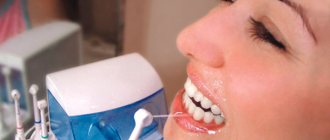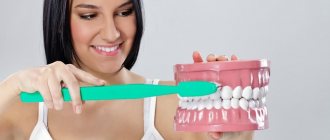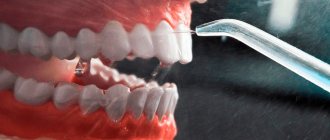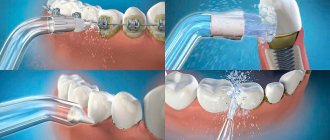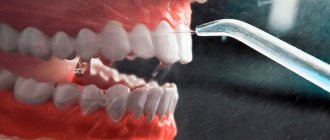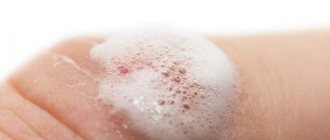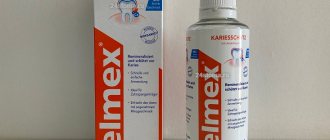The health and beauty of your teeth largely depends on how carefully your oral hygiene is maintained. Cleaning teeth from food debris and plaque with a toothbrush, due to the complexity of the dentition, the presence of hard-to-reach areas, and interdental spaces, is not effective enough. Dentists have long used irrigation in their professional practice to clean teeth. Now the home arsenal of dental care products has been replenished with a new device - an oral irrigator.
Why do you need an irrigator?
Irrigator is a derivative of the Latin word irrigatum, which means “to irrigate.” This is a device that allows you to use water to clean your teeth from organic residues remaining in the mouth after eating. The irrigator does not replace the action of a toothbrush. An irrigator is especially necessary when wearing orthopedic devices (bridges, brackets, brackets and others). With its help, structural elements and the surface of the teeth that come into contact with them are cleaned.
Is it allowed to leave liquid in the container after the procedure?
If the solution in the reservoir is not completely used up, it is usually tempting to leave it for next time so as not to waste time pouring a new one. You shouldn't do this. The fact is that it forms an excellent breeding ground for bacteria, including pathogenic ones, which, under suitable conditions, will begin to multiply rapidly, making subsequent manipulations with the use of waste filler harmful to the body.
After use, the tube must be rid of any remaining water by allowing it to run empty for a few seconds after drying. This is especially important for portable devices in cold weather conditions (for example, while traveling): when freezing, the liquid expands and can damage the fragile tube.
Operating principle of the irrigator
The principle of operation of the irrigator is based on the flow of a very thin stream of water under high pressure onto the elements of the oral cavity to be cleaned. This method of treating the oral cavity not only washes out the smallest food debris and removes plaque from the teeth, but also massages the gums, which improves blood circulation. The device consists of a hydraulic pump, a container for liquid and a handle with replaceable nozzles.
The reservoir is filled with water or solution, under the action of the compressor the pressure rises, and the liquid rushes to the handle with the nozzle. Different irrigator models provide a variety of water jet supply modes, which can be pulsating, spraying, constant, centered, or spraying. The liquid used is plain water or solutions with added agents that enhance the therapeutic and preventive effect of the procedure. Solutions of fluoridated, calcined liquid, antiseptics, antibacterial drugs, herbal infusions, and compositions for strengthening gums are used. Special attachments on the handle ensure that the water jet reaches areas of the dentition that are inaccessible to a toothbrush and floss.
Selecting a device
When choosing an irrigator, you need to consider several important factors.
Water supply source
In modern stores you can buy irrigators that connect directly to the water supply. Such devices can be exclusively stationary and must always be in the bathroom. When connecting the device to the water supply, it is worth deciding on the issue of cleaning the liquid. To do this, you can use special attachments to protect against harmful bacteria.
An alternative to running water are devices with a special built-in reservoir. When choosing such an irrigator, you should consider whether you are buying a device only for yourself or for the whole family.
Number of modes
In modern irrigators, not one water supply mode is often available, but several. Sometimes the presence of a large number of modes is overestimated, since even inexpensive devices that support only 1-2 modes cope with their task quite well.
However, individual needs must also be taken into account. For example, in the case of sore gums, having a massage mode will be useful, while for small children the pulse mode is best suited.
Many models offer switching between modes during operation.
Power
Another important parameter is the power of the device. Although most irrigators have a regulator, you should still find out the maximum liquid supply power in advance. This indicator for battery-powered devices is significantly lower than stationary devices. Therefore, if you are going to purchase a truly powerful device at the pharmacy, then you need to choose from devices powered by the power grid.
Variety of attachments
The water flow created by the irrigator to cleanse the oral cavity will differ depending on the nozzle selected specifically for the procedure. When deciding on a specific model, it is recommended to give preference to several types. For example, one of them may be better suited for gum massage, while the other may be the optimal choice for orthodontic dental structures (braces).
Developers of modern irrigators for cleaning the oral cavity offer several types of attachments:
- Classic.
- Periodontal, which has a thin tip that efficiently cleans periodontal pockets.
- Orthodontic, which has tiny bristles.
- A special spoon designed to clean the surface of the tongue.
- With mini turbine. In such irrigators, it is possible to switch the direct flow of water to a spiral one.
- To remove plaque. Such devices have 3 tufts of bristles and are combined with a toothbrush.
Benefits of an irrigator
The benefit of the irrigator is better cleaning of the oral mucosa, surface of the teeth, interdental spaces, as well as orthopedic structures. And the absence of a biological substrate for the proliferation of bacteria and the rotting of food debris is the prevention of the development of dental diseases. Medical studies have found that a three-second treatment with pulsating water using an oral irrigator removes up to 99.9% of bioplaque on teeth.
Oral irrigator features:
- Significantly reduces the risk of developing caries.
- Promotes rapid healing of gums through micromassage.
- Disinfects and refreshes the oral cavity with antiseptic solutions.
- Cleans gum pockets and prevents the development of periodontal disease.
- Treats the oral mucosa with medicinal solutions for stomatitis
- Prevents the deposition of pigment on the surface of tooth enamel when smoking, drinking strong coffee, tea, red wine.
- Removes plaque from the mucous membrane of the tongue and gums, which reduces bacterial contamination of the oral cavity.
- Prevents destruction of the enamel coating of teeth when installing braces, braces and other orthopedic devices.
- To reduce trauma to soft tissues due to bleeding and loosening of the gums, replace the toothbrush.
Who should buy
In addition to users of braces and other orthodontic systems, people who:
- want to keep their smile healthy;
- prone to the formation of large amounts of stone;
- fight the problem of unpleasant odor;
- suffer from increased bleeding gums;
- have crooked teeth, due to which certain areas cannot be properly cleaned.
When deciding which mechanism is best, it is important to understand that it only serves as an additional means of cleansing the mouth. It is impossible to replace a brush or, for example, floss with a device of this type.
Dentists recommend using the system three times a week and only if there is an urgent need. This is quite enough to ensure that the gums remain healthy, and “deposits” of food residues do not form in the interdental spaces.
Types of irrigators
Types of irrigators differ from each other in technical characteristics, design, and operating principles. Stationary models are placed in the bathroom and operate from the mains. They are equipped with a large capacity for liquid and have a powerful engine that creates a high level of pressure. The device is usually used by the whole family, so it comes with many attachments.
Flaws:
- The energy source is too small to create the required water jet pressure.
- The need to frequently replace batteries or charge the battery.
- The volume of water is not enough to fully clean the oral cavity.
- Flow irrigators are attached to a water tap and use the pressure of the water supply system. Special tap valves allow you to regulate the fluid pressure.
- Mechanical types of irrigators are now rarely used. These are devices in which the pressure required to produce a jet is achieved by mechanical action on the piston. There is a key on the body of the device that is pressed to increase the pressure in the vessel with the liquid. The efficiency of such a device is low
- Tap water mixed with chlorine and heavy metal salts enters the oral cavity.
- There is no pulsation mode.
- Often the water pressure is not enough for effective cleaning.
- Modern models use the latest fine-bubble cleaning method, which is considered the most effective.
- The pulsation mode also promotes the rapid removal of microparticles of organic substances from teeth and orthopedic structures.
Types of removable attachments
Several types of attachments have been developed to perform various oral hygiene tasks:
- The standard one is used for daily brushing of teeth.
- Periodontal is designed to cleanse gum pockets.
- Nozzle for removing plaque from the tongue.
- The orthodontic attachment is used to care for braces and other dental devices.
- The brush attachment performs the work of a classic toothbrush and massages the gums.
- The teeth whitening attachment is used in the process of cleaning and polishing the enamel.
- Manufacturers of irrigators and their features
- In the modern market of dental devices, irrigators are presented in a wide range.
What products should I put in the tank?
The most universal option is ordinary water (not hard, filtered, bottled, tap water is also suitable if it is of good quality) at a temperature of up to 40 °C (hotter water will damage the device with constant use, cold water will damage the enamel). Since the therapeutic effect is achieved through the impact of the jet on the surface and tooth crevices under high pressure, it is not necessary to use special balms. Saline solutions are also suitable.
What can you refuel with?
As prescribed by the dentist for treatment or prevention, it is permissible to use medicinal rinses:
- antibacterial;
- anti-inflammatory;
- strengthening enamel;
- eliminating unpleasant odors and others.
You can prepare herbal decoctions (for example, chamomile) yourself, but you must first consult with a specialist. When using a herbal filler, it is important to ensure that solid particles in its composition do not settle on the inside of the irrigator, and if this happens, wash them immediately.
What not to fill
Prohibited:
- liquids containing oil (it corrodes the insides of the device, and corrosion should not be allowed);
- infusions containing a suspension that can penetrate the internal parts and clog the tube;
- antiseptics (chlorhexidine, hydrogen peroxide) and other drugs for surface use;
- solutions of rinse aids not intended for the device, or toothpaste, as they foam too much and can cause a blockage.
Dentist advice
Before you start using the device, you need to consult a dentist who will help you choose the optimal fluid supply mode, frequency of use, and solution composition. Compliance with all operating rules is the key to safe use of the irrigator. Rules for using the irrigator:
- Cleaning should begin with a gentle regime, gradually increasing power over 7-10 days.
- It is not recommended to use the device earlier than 24 hours after installing any orthodontic structures in the oral cavity.
- The liquid stream should be directed towards the teeth at a right angle.
- It is permissible to use an irrigator for children from 6-7 years of age, always under adult supervision. A high-pressure jet of water entering a child's windpipe can cause tracheal spasm and asphyxia.
- Long-term use of aseptic solutions can disrupt the normal microflora of the oral cavity and cause dysbacteriosis.
- The device can be used for gingivitis and periodontitis only during remission.
- The duration of the procedure is 5-10 minutes.
Can braces be cleaned?
Many teenagers are forced to wear braces to correct their bite. These orthodontic systems are usually firmly attached to the teeth and cannot be removed, making them difficult to clean in the usual way. A special attachment for the irrigator allows you to thoroughly clean the teeth and the braces themselves at the joints, joints, and in hard-to-reach areas. Dentists believe that cleaning with a waterpik is the most effective way to care for children's braces.
It is important to take into account that orthodontic structures are relatively fragile, so it is recommended to clean at low or medium power so as not to damage the braces.
